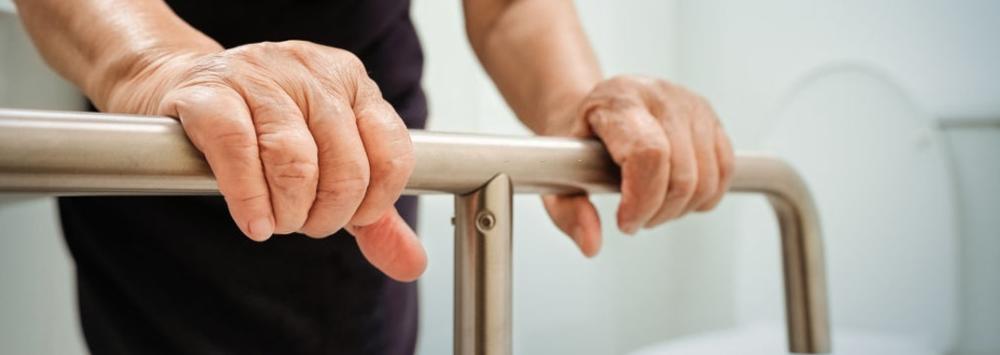
Things You Should Know about Grab Bars and Handles
Sally Madeley-Carr, OT17 Sep 2020
There are now numerous styles of grab rail available for people who require support to maintain their balance around the home. Here we'll run down some of the most popular of these key mobility aids and provide some ideas for the best positions to install them.
Even outside the house, strategically placed rails can assist with climbing steps to the front or back door, or even in sheds or garages.
Grab handles for the bathroom
The bathroom is traditionally one of the main rooms of the home in which to install rails. Because of the potentially slippery surfaces, plus the need to lower and raise the body, there are multiple reasons to fit them.
Next to the sink
Standing at the sink may become difficult if you're living with certain physical conditions. Just a short rail can make a big difference, providing something to hold while brushing your teeth.
Sometimes a rail in combination with a perching stool works well. The two together provide excellent combined support.
Next to the toilet
If you have discomfort when either sitting down or standing up again when using the toilet, a rail fitted to the wall next to it may be of benefit. An ordinary straight rail may well be enough, but there are larger installations available if you need them.
One option is a U-shaped drop-down rail like the 'Folding Support Arm' in Essential Aids' range. It folds down from the wall when in use, providing a double horizontal support bar. It creates a stable leaning point, perfect for supporting the user as they sit down and stand up again.
When not in use, the rail clicks firmly against the wall, putting it well out of the way when others use the toilet.
For the maximum stability, some U-shaped rails are available with an additional support leg. These models have an increased weight tolerance, so are ideal for bariatric individuals.
Toilet frames are another option to help with transferring from a standing position to sitting, and back into standing. These aids sit on the floor around the pedestal, providing a waist high support point. Usually they are freestanding, but in some cases can be fixed to the floor in order to increase stability.
Most of the free-standing models are height and width adjustable. Some are made of steel, but increasing alumunium is the choice material, mainly because of its light weight and resistance to the corrosion in bathrooms.
Many models have a built in raised toilet seat. This has the benefit of reducing the distance of travel between standing up and sitting down.
Bath rails
Getting in and out of the bath can be a precarious process if you have compromised balance, strength or coordination. With the surface of the bath wet, slipping is something we all want to avoid.
Some people choose to fix a grab rail to the wall next to the bath, just to provide a point to steady themselves.
If the bath is fitted against the wall, a wall rail may not be in an ideal position. Support on the 'open' side of the bath is potentially more beneficial.
A better option may be a bath rail fitted to the bath side itself which extend upwards, giving the user support in the immediate area that they need it, as they left their leg over the bath side.
As with wall-mounted rails, most bath rails feature curved, almost U-shaped tubing. This, in addition to the typically wide diameter, means they don't have corners or sharp edges on which you might injure yourself, should there be a fall.
This type of rail clamps securely to the outside wall of the bath and in most cases will extend upwards to around 20 inches above the bath-side's height. Because of their positioning away from the wall, bath rails may also offer support as you get dressed or undressed.
Essential Aids supplies a number of these rails, each with a slightly different specification or clamping mechanism. One of the most popular is the Deluxe Bathtub Grab Bar. It has the high, curved rail described above and features a secure clamping system which requires no tools to install.
Suction grab rails
Rails which use suction to fix to tiled surfaces are an option if you don't want to screw conventional rails to the wall.
Suction grab handles work well on strengthened glass or tiles which are completely flat and smooth, but are not suitable if there's any kind of indentation pattern to the tile's surface.
Modern units have very large, wide-diameter suction cups which use an internal valve and switching mechanism to ensure they fix firmly in place. A switch is used to release the suction when it's time to remove the rail.
Grab rails for the shower
Rails fitted within the shower cubicle makes sense if you find yourself needing support in this potentially slippery area of the bathroom. Non-slip shower mats are also a good idea if the floor of the cubicle gets slippery.
The rails themselves are the same as those for around the bath. They are generally available in white or chrome finishes, some with a smooth grip and others with an indented or textured surface. The latter can be of great benefit in wet environments.
It's a good idea to enter the shower and use tape to mark exactly where a rails might be of most benefit, without it impeding your entry and exit to the cubicle. If you're also using a shower stool, think about how this might work in tandem with a rail.
While the rails themselves will likely be made of non-corrosive aluminium or plastic, it's important that whoever fits them also uses non-corrosive screws as fixings. Vertical rust stains from inappropriate screws are a common sight when this last point is overlooked, so it's worth mentioning to the installer.
In terms of aesthetics, modern rails are inconspicuous in design and most blend in well, particularly in mostly white bathrooms.
Alternative bathroom grab rails
Fitting rails to the walls is easily the most common choice, but if you have adequate space, you might consider a floor to ceiling support pole. The 'Security Pole and Curve Grab Bar' at essentialaids.com is an innovative piece of equipment which is usually fitted quite near to the toilet.
As the name suggests, it extends the full height of the room. It has the additional feature of a curve horizontal rail which protrudes from the vertical pole, providing support more centrally in the room. The curvature of the rail provides a number of different hand holds.
While some similar rails require permanent fixing, this particular one does not. Instead it has a tension mounting within its tubing, meaning it can be securely wedged into position and the mechanism tightened to exert pressure on the floor and ceiling, holding the pole in place.
While it's most often used in bathrooms, these particular mobility aids are also suitable for the bedroom. The versatility of their positioning is making them an increasingly popular choice.
Bed rails
Support rails which fit to the bed help with the process of getting in and out of it, while they can also assist with the getting dressed and undressed. They may also be a useful aid in moving from a lying down position to sitting up in bed.
Many bed rails act like cot sides, offering a point of leverage for the user. Some models fold down out of the way as required, allowing easy access to the bed.
Other smaller models act in a similar way to the upside down U-shape of rail sometimes found in bathrooms fixed to the bathtub. These tend to be smaller, leaving plenty of room either side to access the bed.
Handrails for the stairs
Stairs are an obvious area of potential danger if you are unsteady on your feet and many people decide to fit rails as mobility aids. If it's an enclosed corridor staircase, it's possible to fit either a rail on one side or even on both if you feel it's necessary.
More open staircases will have the bannister on one side, but people may also fit a rail on the wall for the length of the stairs too.
Additionally special rails are available for the newel posts at the foot and top of the stairs. These wind around the post, providing support for the last one or two steps as you descend. They are available in either left or right handed versions, depending on the side of the staircase the newel post is on.
Outside grab rails
Many front and back doors have small flights of steps leading up to them and fitting a rail next to these may make sense for some people.
Out in the elements 24/7, it's important to choose one which is robust and non-corrosive. Usually dark colours are the most logical choice for this task.
Essential Aids supply the 'Outdoor Grab Rail' for exactly this purpose. It features a non-slip, ribbed holding surface so it offers grip even in the rain.

Sally Madeley-Carr, OT
Sally qualified as an Occupational Therapist in 1996 and is a well-respected professional in the field of rehabilitation equipment and living aids. She has worked in private practice and within the NHS, developing a broad experience with adults and children. Click here for Sally's registration with the Health and Care Professions Council. The HCPC regulates health, psychological and social work professionals in the UK.